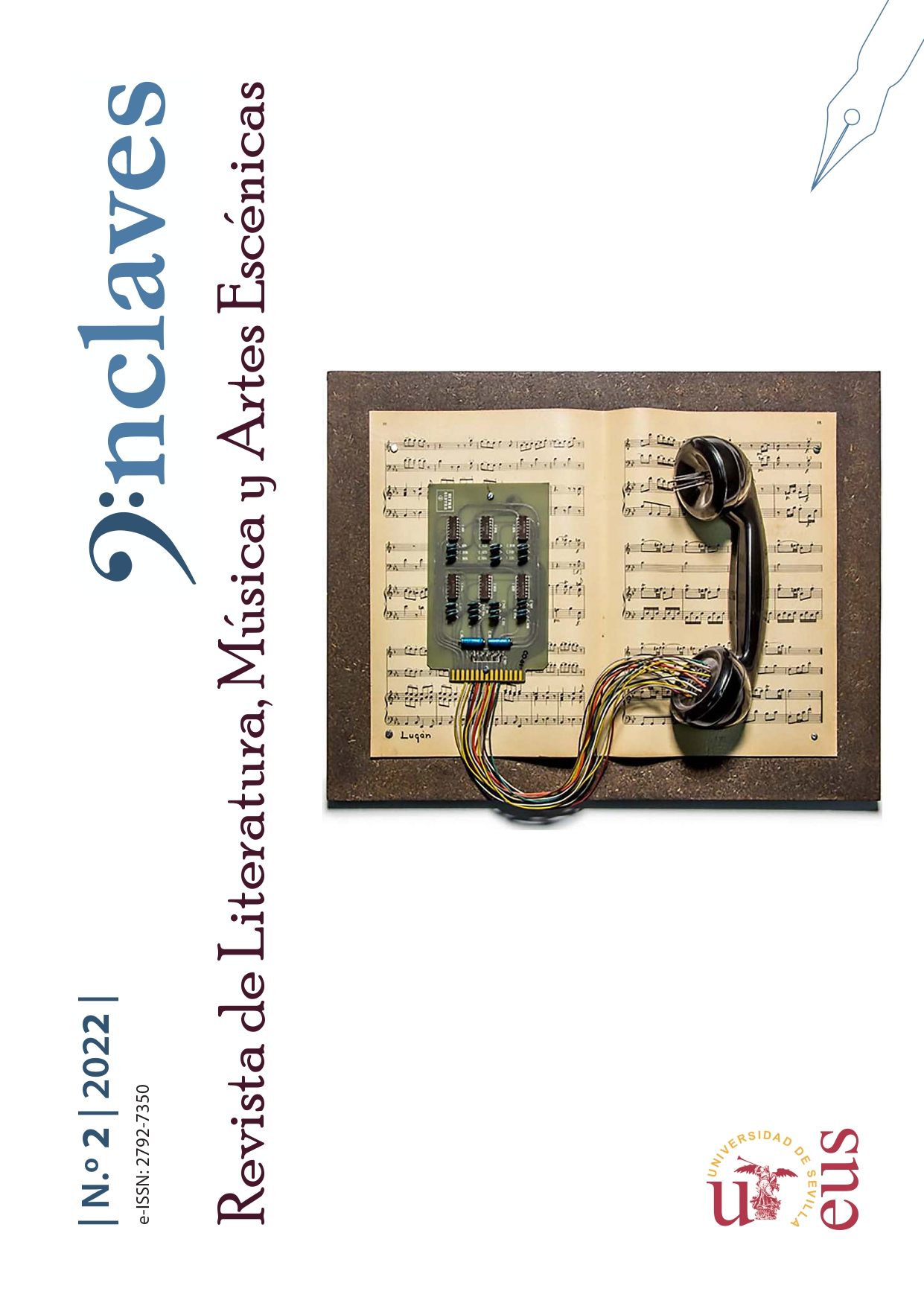Voice, Time and Space. The Presence of the Sound Element and its Inscription in the Work of Artist Esther Ferrer
Keywords:
Sound, Art, Voice, Time, Space, ListeningAbstract
In the work of artist Esther Ferrer (San Sebastian, 1937), sound material plays a fundamental role as a network of space-time relationships and an intersubjective phenomenon. Although Esther Ferrer has never considered herself a musician or a sound artist, sound, rhythm, space, time, the vocal body and the physical body, writing and listening, in all their variations, are key elements through which it is possible to approach her practice and thought. The artistic condition of the sound phenomenon is intimately linked to the way of inscribing and organizing time and space in a specific situation. The sound devices (mostly participatory and procedural) and discursive procedures that participate in the experimentation of the medium structure the action, amplifying and multiplying its sensory and perceptive possibilities. The works presented in this article, Al ritmo del tiempo (1992) and two participatory performances, La coral del miedo (2016) and Concierto zaj para 30 o 60 voces (2010), share the voice as a common axis: a relational and procedural phenomenon, the voice arises from a set of sound materialities that affect each other and forge the experience of a spatial, temporal and sensory situation. Always open to participation, Esther Ferrer favors the multiplication and intensification of the performative action through the incorporation of off-screen elements that contribute their own eventuality, thus broadening the points of enunciation and the listening points of the medium.
Downloads
References
Arfuch, Leonor. “Cronotopías de la intimidad”. Pensar este tiempo. Espacios afectos, pertenencias, compilado por Leonor Arfuch. Buenos Aires: Paidós, 2005, pp. 237-290.
Barber, Llorenç. “El arte sonoro español en el contexto mundial. Una narración desde mi experiencia”. Quodlibet, n.º 68, 2018, pp. 9-62, https://ebuah.uah.es/dspace/bitstream/handle/10017/38131/arte_barber_QB_2018.pdf?sequence=1&isAllowed=y. Acceso 7 agosto 2022.
Celedón B., Gustavo. “John Cage y la posibilidad de pensar en sonido como acontecimiento. Aproximaciones filosóficas a su obra”. Revista Musical Chilena, vol. 69, n.º 223, 2015, pp. 73-85.
CentroCentro. “VANG. Músicas en Vanguardia | Esther Ferrer”. YouTube, 20 de mayo de 2020, https://www.youtube.com/watch?v=zWycMr2FY3Y. Acceso 11 agosto 2022.
Daniel, Marion. “Esther Ferrer. Sur L’Art de la performance: théorie et pratique”. Paperboard: conférence performance: artistes et cas d’étude, dirigido por Laurence Corbel y Christophe Viart. París: T&P Publishing, 2021, pp. 98-117.
Daniel, Marion. “Réelle et différée”. estherferrer.fr, https://estherferrer.fr/images/pdf/MarionDaniel.pdf. Acceso 6 noviembre 2023.
Deleuze, Gilles, y Félix Guattari. Capitalisme et schizophrénie. París: Minuit, 1980.
Ferrer, Esther. “Similitudes et différences”. Inter Art Actuel, n.º 74, 1999, pp. 26-28, https://www.erudit.org/fr/revues/inter/1999-n74-inter1104337/46207ac.pdf. Acceso 10 agosto 2022.
Ferrer, Esther. “Le son marque le temps”. Sesión 5 del ciclo de conferencias REFLEXIO, Universidad París 8. Les Instants Chavirés et Synesthésie – MMaintenant, 2019, s/p, https://www.instantschavires.com/reflexio-2019-5conferenceesther-ferrer18h30-a-synesthesie-mmaintenant/. Acceso 3 agosto 2022.
Ferrer, Esther, et al. “Todas las variaciones son válidas, incluida esta”. Todas las variaciones son válidas, incluida esta. Catálogo de exposición. Madrid: Museo Nacional Centro de Arte Reina Sofía, 2017, pp. 53-108.
Iges, José. “Esther Ferrer’s interview | Entrevista a Esther Ferrer”. Soundcloud, subido por Galeria Freijo, 1992, https://soundcloud.com/user-112080237/esther-ferrers-interview-entrevista-a-esther-ferrer. Acceso 7 agosto 2022.
Iges, José, y José Luis Maire. “¿Qué es el arte sonoro?”. Escuchar con los ojos. Arte sonoro en España, 1961-2016, editado por Fontán del Junco, Manuel, et al, Madrid: Fundación Juan March, 2016.
Jiménez, Carlos. “ZAJ: El oído en el ojo”. Lápiz, n.º 56, febrero, 1989, pp. 41-48.
Jullien, François. L’écart et l’entre – Leçon inaugurale de la Chaire sur l’altérité. París: Galilée, 2012.
Luna, Diego. “El potencial político del gesto: Una introducción a ZAJ a través de sus propuestas”. Essais, n.º 9, 2016, pp. 48-63, http://journals.openedition.org/essais/4387. Acceso 5 agosto 2022.
Nancy, Jean-Luc. À l'écoute. París: Galilée, 2002.
Pardo Salgado, Carmen. “La escucha en continuidad”. Contrastes, n.º 13, 2008, pp. 139-157.
Pardo Salgado, Carmen. “En los arenales del arte sonoro”. Arte y Políticas de la Identidad, n.º 7, 2012, pp. 15-28.
“Programa 018 - Enclave Contemporáneo - Arte Sonoro”. Youtube, subido por El compositor habla, 17 de abril de 2021, www.youtube.com/watch?v=usZiOq0aiY0&t=4037s. Acceso 5 julio 2022.
Rivière, Henar. “La escritura performativa del grupo zaj: arte postal, libros de artista, etcéteras”. Hispanic Issues On Line, n.º 21, 2018, pp. 136-168.
Salgado, María F. “Una acción. Un cuadrado. Un piano”. Todas las variaciones son válidas, incluida esta. Catálogo de exposición. Madrid: Museo Nacional Centro de Arte Reina Sofía, 2017, pp. 153-185.
Solomos, Makis. “L’écoute musicale comme construction du commun”. Circuit, vol. 28, n.º 3, 2018, pp. 53-64, https://doi.org/10.7202/1055194ar. Acceso 5 agosto 2022.
Downloads
Published
How to Cite
Issue
Section
Categories
License
Copyright (c) 2022 Coral Nieto García

This work is licensed under a Creative Commons Attribution-NonCommercial-NoDerivatives 4.0 International License.


